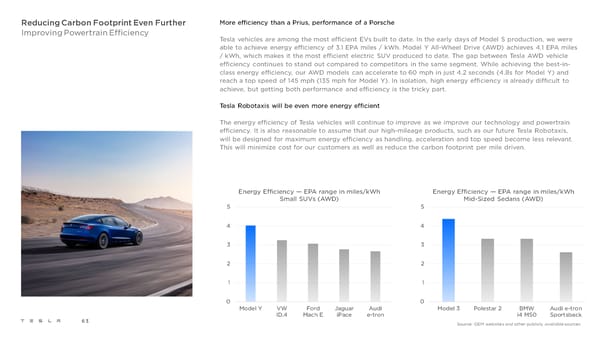Reducing Carbon Footprint Even Further More efficiency than a Prius, performance of a Porsche Improving Powertrain Efficiency Tesla vehicles are among the most efficient EVs built to date. In the early days of Model S production, we were able to achieve energy efficiency of 3.1 EPA miles / kWh. Model Y All-Wheel Drive (AWD) achieves 4.1 EPA miles / kWh, which makes it the most efficient electric SUV produced to date. The gap between Tesla AWD vehicle efficiency continues to stand out compared to competitors in the same segment. While achieving the best-in- class energy efficiency, our AWD models can accelerate to 60 mph in just 4.2 seconds (4.8s for Model Y) and reach a top speed of 145 mph (135 mph for Model Y). In isolation, high energy efficiency is already difficult to achieve, but getting both performance and efficiency is the tricky part. Tesla Robotaxis will be even more energy efficient The energy efficiency of Tesla vehicles will continue to improve as we improve our technology and powertrain efficiency. It is also reasonable to assume that our high-mileage products, such as our future Tesla Robotaxis, will be designed for maximum energy efficiency as handling, acceleration and top speed become less relevant. This will minimize cost for our customers as well as reduce the carbon footprint per mile driven. Energy Efficiency — EPA range in miles/kWh Energy Efficiency — EPA range in miles/kWh Small SUVs (AWD) Mid-Sized Sedans (AWD) 5 5 4 4 3 3 2 2 1 1 0 0 Model Y VW Ford Jaguar Audi Model 3 Polestar 2 BMW Audi e-tron ID.4 Mach E iPace e-tron i4 M50 Sportsback 63 Source: OEM websites and other publicly available sources
 Tesla 2021 Impact Report Page 62 Page 64
Tesla 2021 Impact Report Page 62 Page 64